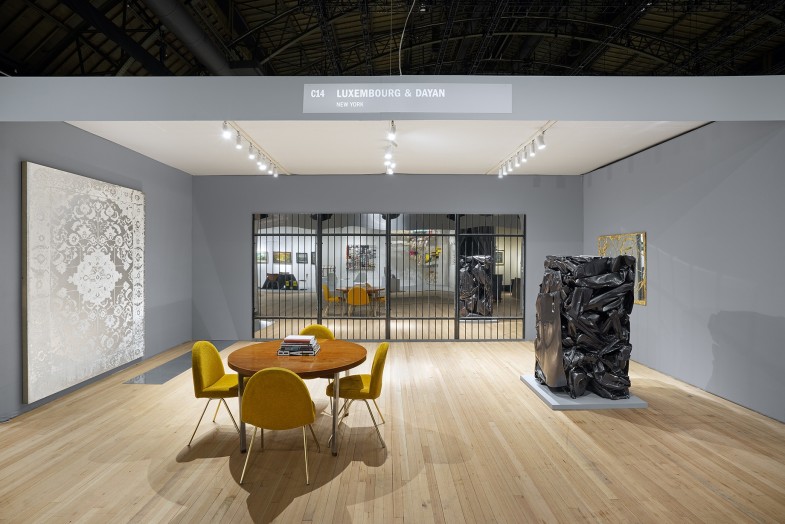ADAA's The Art Show
February 27 – March 1, 2020
Park Avenue Armory
Park Avenue at 67th Street, NYC
Luxembourg & Dayan | Booth C14
New York… For its stand at ADAA's 2020 edition of The Art Show, Luxembourg & Dayan will present works by modern and contemporary artists who have used mirrors as medium and subject to challenge the ways in which viewers reflect upon individual and collective experience. Michelangelo Pistoletto's Arte Povera masterwork La Gabbia (The Cage) (1962-1974) will be complemented by works by Enrico Baj, Carl Andre, César, and Rudolf Stingel.
Pistoletto (b. 1933) once remarked: "Artists in the 20th century gained the maximum of autonomy and subjectivity in their expression. I came to the mirror to try to transmit the idea that each viewer can have the same autonomous responsibility as the artist. People should … take a little bit more responsibility for their own freedom."[1] Few pieces better reflect this point of view than La Gabbia. Consisting of mirrored panels with silkscreen images of steel bars, Pistoletto's tour de force echoes the formal concerns of Minimalism while enmeshing viewers in its charged political content. Standing before La Gabbia, we are situated simultaneously within and outside of a jail cell, becoming both detainee and guard. The artist thus implicated his original viewers in the corporal punishment and incarceration that swept Italy during the period known as Anni di pimobo ("Years of Lead") when this work was made-and now brings us face-to-face with crises of justice, human rights, and the quest for freedom in today's world.
When La Gabbia debuted in 1974 at the Sidney Janis Gallery, its panels were installed to surround the spectator, placing the viewer firmly inside a cage. At The Art Show 2020, La Gabbia instead will be mounted along one wall, re-contextualizing the work and inviting dialogue with other objects on view in Luxembourg & Dayan's booth. Among these are Specchio (Mirror) (1960) by Enrico Baj (1924-2003), a piece that conveys the preoccupation with nuclear war that its legendary Italian maker shared with fell0w members of the Arte Nucleare group founded in Milan in 1951. Specchio depicts fragmented figures with mirror shards that reflect and fracture the onlooker's likeness. As quoted by critic Andrè Pieyre de Mandiargues, Baj said that the mirror "definitely solves the problem of letting the spectator enter into the work of art."[2]
At The Art Show, Luxembourg & Dayan will also juxtapose the Minimalist aesthetics of La Gabbia with an exemplary floor sculpture by Carl Andre (b. 1935). Andre created Fifth Aluminum Cardinal (1978) in Tokyo on the occasion of his first solo exhibition in Asia. It is part of his classic series from the 1970s based on the cardinal number system, with each work consisting of an exact number of identical units. The artist executed these pieces in three materials: first aluminum, then copper, and, finally, steel. Andre explained these forms as "causeways" that "cause you to make your way along them or around them or to move the spectator over them."[3] Made of a specific reflective material, Fifth Aluminum Cardinal especially engages the viewer in the almost performative manner that Andre described.
The iconic compressed vehicle sculptures by French artist César (1921-1998) are represented in the stand by Black Storm 805 (1998). Begun in 1960, César's engagement with the automobile as both totem and medium culminated with his 1998 Suite Milanese. A prime example from this series, Black Storm 805 is a crushed Fiat 805 car painted with a high-gloss finish identified as "Black Storm" by its manufacturer. With this reflective object, César conveyed the ideals of the Nouveau Réalisme movement: he erased boundaries between art and life by transforming the surface of a common vehicle into a shimmering palette of reflected everyday visages.
Finally, Untitled (2011) by Italian artist Rudolf Stingel (b. 1956) unsettles traditional spatial relationships among viewers, paintings, and interior décor. Executed in oil and enamel, Untitled borrows the ornate patterns of an Oriental rug and evokes the tactile texture of its source. By moving a carpet from the floor to the wall, and placing it as a mirror before us, Stingel disrupts the familiar visual processing that shapes how we see ourselves relative to our surroundings. As curator Francesco Bonami explains: "A carpet is a painting, and a painting is a carpet. It is only our position in relation to them that changes. Our relation to life, to a painting or to a carpet, is the same relation we have to the earth we stand on: it moves but we don't feel it."[4]
###
For additional information, please contact:
Andrea Schwan, Andrea Schwan Inc.
info@andreaschwan.com
+1 917 371 5023
[1] A. Walleston, "Pistoletto Is Our Mirror," Art in America (April 4, 2012).
[2] Translated from Baj's original Italian quote: "impiego dello specchio 'risolve definitivamente il problema di far entrare lo spettatore all'interno dell'opera d'arte.'" A. P. de Mandiargues, "Les miroirs de Baj" in Front Unique (Paris: January 1960), reproduced in M. Corgnati, Enrico Baj: Opere 1951-2003 (Milan: Skira, 2003), p. 94.
[3] P. Tuchman, "An Interview with Carl Andre," Artforum 8:10 (June 1970), p. 57.
[4] F. Bonami, Rudolf Stingel (New York: Gagosian, 2010), p. 7.

